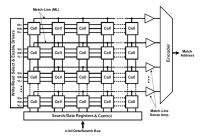








Content-addressable memory (CAM) is a special type of computer memory used in certain very-high-speed searching applications. It is also known as associative memory, associative storage, or associative array, although the last term is more often used for a programming data structure.It compares input search data (tag) against a table of stored data, and returns the address of matching data (or in the case of associative memory, the matching data).Several custom computers, like the Goodyear STARAN, were built to implement CAM, and were designated associative computers.
Dudley Buck invented recognition unit memory.Also called content addressable memory, it is a technique of storing and retrieving data in which there is no need to know the location of that data. Not only is there no need to query an index for the location of data, the inquiry for data is broadcast to all memory elements simultaneously; thus data retrieval time is independent of the size of the database.
FeRAM was first built by Buck as part of his thesis work in 1952. In addition to its use as computer memory, ferroelectric materials can be used to build shift registers, logic, and amplifiers. Buck showed that a ferroelectric switch could be useful to perform memory addressing.